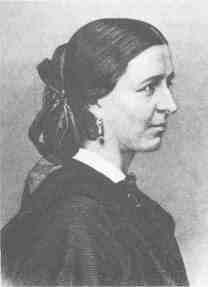by Laurel | February 12th, 2014
12 February 1901
They Fought in the Civil War
Clad in Men’s Uniforms They Did Their Part
Toward Saving the Union — Some Romantic Stories
The discovery following the death in New York the other day of Murray Hall, that well known Tammany politician, roisterer, and “all around sport” of 30 years’ standing was not a man at all, but a woman, has brought to light a number of revelations concerning women who have successfully masqueraded as men in peace and war. A Washington man who has been in he war department for more than 40 years, and who during the civil war kept a record of all the cases that came to his notice wherein women were discovered under arms in both services, federal and confederate, gave the writer hereof access to his “women soldiers” data the other day, and the matter is both peculiar and interesting.
Physical examinations for enlistment during the civil war did not amount to much more than the recruiting officer’s eye measurement of the applicant’s inches. If the applicant approximated five feet in height and was not obviously blind, halt, lame or deaf and dumb, admission to the ranks were given, and this was particularity the case when the war had been in progress for a couple of years. The wonder does not, therefore, seem so great that a considerable number of women actually soldiered as uniformed men during the civil war. A majority of these adventurous women enlisted on the Union side, and their sex in most cases was only revealed when they were wounded in action. There were doubtless many more women who enlisted in the armies on both sides as men than the records show — women, who, having escaped wounds and detection, were mustered out at the close of their enlistments, or at the conclusion of the war, without their actual sex becoming known to their officers or comrades. It seem almost incredible that some of these women, whose cases are well authenticated, should have carried out their deceptions with such success under difficult circumstances, but the fact remains that very few of them were discovered to be women through their poor acting of their soldierly roles.A girl of 22, names Frances Hook, who is described as “of about medium height, with dark hazel eyes, dark brown hair, rounded features, and feminine voice and appearance” enlisted with her bother in the 65th Illinois home guards shortly after the beginning of the civil war. She and her brother were orphans. In enlisting the girl assumed the name of Frank Miller. She served three months, and was mustered out without the slightest suspicion as to her sex having arisen Her bother was killed in action soon after he enlisted. after receiving her three-months’ discharge the girl “Frank Miller” re-enlisted in the Union army, this time in the 90th Illinois.
She was taken prisoner in a battle near Chattanooga. In attempting to escape she was shot through the calf of the right leg. The Confederate soldiers who picked her up searched her for papers and discovered her sex. The confederates respected her sex and gave her a separate room in the military prison in Atlanta. The girl claimed that during her captivity she received a letter from Jefferson David offering her a lieutenant’s commission, is she would accept the confederate service, but this fact has never been verified. The girl had no hoe and no relatives, but she said that she would rather fight as a private soldier for the stars and stripes than accept any commission up to that of lieutenant-general in the confederate army. She was eventually exchanged. She said upon reaching the North that her captors had tried to extort from her a promise that she would go home and not enter the Union service again.
“Go home?” she replied. “Go home, and my brother, the only living relative I had in the world killed by my side at Pittsburg Landing? I’ve got no home to go to, and I would not go to it, even if I had one, until the war is over.”
This young woman’s subsequent career to the service, if, indeed, she again re-enlisted, is not known.
The brother of a young Ohio girl had enlisted and she determined to join him. She was inspected, accepted and sworn in wit the rest of her company. The company marched to Camp Jackson, Ohio, and drilled there for several days, when the girl was sent with the 3d Ohio Regiment to Camp Dennison, near Cincinnati. Here she assisted in all the duties in forming a new camp, handling lumber, doing sentry duty, etc., for a couple of weeks, when, ascertaining for the first time that there were two Camp Dennisons, and that her brother was stationed in the other one near Lancaster, Pa., she went to her commanding officer, Col. Morrow, and requested to be transferred to the Camp Dennison in Pennsylvania, giving as her reason that she preferred to associate with Americans, and that most of the men in the outfit to which she was attached were foreigners. Col. Morrow, a shrewd man, discovered the girls sex, and dismissed her from the camp.
A bright little girl of 12 years of age enlisted as a drummer boy in one of the Pennsylvania regiments in the early period of the war. She gave the name of Charles Martin. She was of good stock, apparently, and had evidently enjoyed the advantages of an education., for she wrote an excellent hand and made herself useful to the officers of the regiment in the capacity of clerk She was involved in the chances of five battles, but she escaped unharmed. The officers never dreamed of any question as to the child’s sex. She was finally taken ill with typhoid fever and was removed to the Pennsylvania hospital in Philadelphia. here one of the female nurses discovered her sex, and the brave little girl was returned to her own people, who had mourned her as dead.
A girl named Fannie Wilson enlisted in the 24th New Jersey, in order to follow her sweetheart, who was a member of the same regiment, into the field. He knew nothing of her action, but she saw him every day, and came near to being assigned to the same mess tent with him. The 24th New Jersey fought through the first campaign in western Virginia, the girl soldier carrying herself valiantly. The the regiment was ordered before Vicksburg. The girls lover was wounded and, without revealing her sex, Miss Wilson nursed him. She only made herself known to him just before he died. The girl herself became ill when her lover was laid away, and, with a large number of sick and wounded, was sent to Cairo, Ill. Here her sex was revealed, and upon her recovery, she was dismissed from the service. The girl was thrown upon her own resources at Cairo, and for a time served an engagement as a ballet girl. Then she went to Memphis and enlisted again, this time in a cavalry regiment, the 3d Illinois. Her sex was discovered after a couple of weeks. She was help help up by her guard and arrested for being a woman in man’s clothing. She was taken to the office of the commanding officer, it being suspected that she might be a confederate spy, but she made it clear she was a good, loyal federal soldier. She was provided with an outfit of women’s clothes and sent back North.
A young woman named Mary Owens of Danville, Montour County, Pennsylvania, enlisted in order to be with her husband. The girl’s father had been violently opposed to her marriage. The couple were married secretly, and the young wife donned the United Sates uniform, enlisted under the name of John Evans in the same company with her husband, endured all of the hardships of the camp and the dangers of the field, saw her husband fall dead by her side, and returned home wounded. Her sex was not discovered while she was in the service. She was in the service for 18 months, took part in three battles, ad was wounded twice, both times in the arm. She dressed her wounds herself in order to preserve the secret of her sex. She was a Welsh girl, and pretty and clever.
A Brooklyn girl, whose name is not given, tried hard to enlist in several Brooklyn recruiting offices without success. She went to Ann Arbor, Mich., where she had relatives and remained with them long enough to ascertain the whereabouts of the Michigan regiments. Then she went to Detroit, where she joined the drum corps of on of the Wolverton regiments. her sex was not discovered, and she was sent with her regiment to the army of the Cumberland. She survived the hardships of the Kentucky campaign where so many strong men went down. her regiment had a place in the division of the gallant Van Cleve, and during the battle of Lookout Mountain she was struck on the left side by a minie ball. the surgeon discovered her sec, and told the girl that her wound was mortal. She dictated a letter to her parents in Brooklyn, and died within an hour after she was shot.
Mrs. Belle Reynolds, the wife of Lieut Reynolds of Co. A, 7th Illinois Regiment, was with her husband during several beavy battles, including that of Fort Donelson, and for he valiant conduct when was commissioned a major by Gov. Yates of Illinois. Mrs. Reynold, however, made no effort to conceal her sex.
A young woman, 19 years of age, attending a convent near Wheeling W. Va., ran away from the institution to join the arm in 1862. She enlisted, undiscovered as to her sex, in the 2d Tennessee Cavalry, and accompanied the army of the Cumberland to Bashville. She was in the thickest of the fight at Murfreesboro and was wounded in the shoulder. The surgeon who dressed her wound discovered her sex, and Gen. Rosecrabs was made acquainted with the case. the young woman was mustered out. Rosecrabs was very favorably impressed with the girl’s nerve, and himself saw to the arrangements for shipping her to her own people.
She did not proceed to her home, but went to Bowling Green, where she enlisted in the 8th Michigan as a regimental bugler. She was a first-rate horsewoman, and bravely endured the hardship incident to the life of a soldier. She gained some reputation as a scout, having made several remarkable expeditions which were attended with signal success. She was a tall girl of good figure, auburn hair and blue eyes. When her sex was discovered for the second time, and she was mustered out, she took it good-naturedly and went to the house of her parents. This young woman stated that she had discovered a good many women in the army, and that she was intimately acquainted with a young woman who held a lieutenant’s commission. She ha, she said, assisted in burying three female soldiers at different times, whose sex was unknown to any but herself.
The history of Maj. Pauline Cushman, the federal scout and spy is familiar to students of the Civil War. Miss Cushman resided in Cleveland, Ohio, and upon going to Louisville to take part in a theatrical entertainment, she was arrested as a southern spy by the federal authorities. She proved her loyalty by offering to enter the service of the Union army. Her services were accepted, and her achievements are a matter of history. She penetrated the southern lines time and again in the disguise of a confederate soldier, and her identity was never discovered.
A girl named Annie Lallybridge of Detroit became betrothed to a lieutenant in the 21st Michigan, and determined to share the fortunes of war with him without his knowledge. She enlisted in the same regiment, but in another company, and carefully preserved the secret of her identity. One of her comrades, after several months of hard service alongside the girl in Kentucky, became aware of the secret as to her sex, but promised to hold his peace about it, and when he was killed in battle the girl found his body on the field. She was finally disabled by a shot in the arm, and, her sex being discovered, she was sent to her home.
Adapted from The Springfield Republican via The Washington Post.
Image courtesy Courtesy Illinois Periodicals Online.









